SUBJECTS
GRADE
Show Results
Northwestern Shoshone Fish Song

Lesson Summary
- Sing a Northwestern Shoshone song.
- Write a narrative story about an experience in nature.
- Create music compositions patterned after the song.
Lesson Plan and Procedure
Lesson Key Facts
- Grade(s): 3, 4, 5, 6, 7
- Subject(s): English Language Arts, Music, Social Studies, Native American, Tribe Approved
- Duration of lesson: Three sessions, 45-60 minutes each
- Author(s): Patty Timbimboo-Madsen, Emily Soderborg, and Paula Watkins
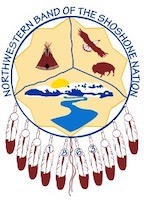
The Northwestern Band of the Shoshone Nation selected this lesson content in answer to the question, “What would you like the students of Utah to know about you?” Patty Timbimboo-Madsen, the NWBSN History and Culture Specialist, represented the Northwestern Band of the Shoshone Nation in crafting the lesson to provide expertise, accuracy, and authenticity. Additional input was given by Paula Watkins, NWBSN library consultant.
Before teaching this lesson, please explain to your students that there are many Native tribes in the United States and that this lesson specifically focuses on the Northwestern Band of the Shoshone Nation and does not represent other Native American groups. We hope that other Native tribes will respect the Northwestern Band of the Shoshone Nation's choice to share this aspect of their culture.
Note: Not all Northwestern Shoshone songs are appropriate for students to sing in a classroom. However, Patty Timbimboo-Madsen has given permission for classroom teachers to have students sing this specific song, "Pengwi Bai Anoga." She believes that singing this song will help students to better understand how Northwestern Shoshone people see their surrounding environment. This song is traditionally sung while passing time, perhaps when a Shoshone is outside and sees something that brings this song to mind, like fish swimming or water rippling.
Session One: Learning the song "Pengwi Bai Anoga"
Learning the melody
Teacher: Copy the actions of where I move my hands as we listen to this song today.
Touch the following parts of the body with each note of the song while listening to the recording of Paula Watkins singing "Pengwi Bai Anoga":
shoulders shoulders head head shoulders waist
Pen — gwi bai a — no — ga,
knees knees waist waist knees toes
pen — gwi bai a — no — ga,
toes toes toes toes toes toes toes toes
pen — gwi bai a — no — ga, eh — na
shoulders shoulders head head shoulders waist
Pen — gwi bai a — no — ga,
knees knees waist waist knees toes
pen — gwi bai a — no — ga,
toes toes toes toes toes toes toes toes
pen — gwi bai a — no — ga, eh — na
waist knees waist waist knees toes
Bu — hip bai a — no — ga,
waist knees waist waist knees toes
bu — hip bai a — no — ga,
toes toes toes toes toes toes toes toes
bu — hip bai a — no — ga, eh — na
waist knees waist waist knees toes
Bu — hip bai a — no — ga,
toes toes waist waist knees toes
bu — hip bai a — no — ga,
toes toes toes toes toes toes toes toes
bu — hip bai a — no — ga, eh — na
(repeat this whole sequence two more times until the song finishes)
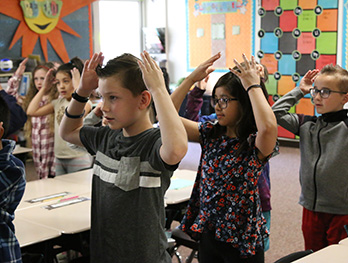
Teacher: Did you hear any large patterns in the song repeated?
Listen for student responses.
Teacher: There were two main sections in the song. We are going to call the first section A. That was the section where we touched our head and shoulders. We did the exact same movements twice in a row before starting the second section.
We will call the second section B. That was the section where we stayed touching our waist, knees, and toes the whole time. Did you hear that it was almost the same pattern within the B section, but there were small differences each time? We're going to move with our bodies again, and see if we can figure out those small differences in the B section.
Listen to the recording again, and move silently showing the melody on the levels of the body.
Teacher: This time as we listen we are going to follow a line that represents the melody of each phrase. As we listen, follow the shape, or contour, of the melody by tracing the line in the air with your finger.
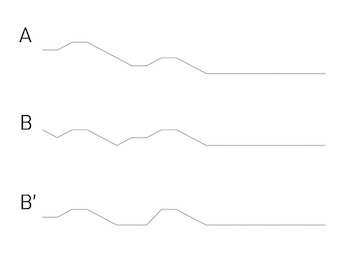

Teacher: Think back about the different body levels we used to represent the melody. How many different parts of our body did we touch? Five. Each of these levels on the body represents a different note in the song. These notes have names that show the relationship between the notes called solfa. No matter what actual note we start on–for example, if we were using note letters, like some of you might know from learning an instrument–the relationship stays the same, so we can use the same solfa every time.
Head = la
Shoulders = sol (said so with a silent "l")
Waist = mi (said "me")
Knees = re (said "ray")
Toes = do (said "dough")
Teacher: Try to sing the solfa names as we show different body levels.
Touch your head and see if the students sing "la." Touch your shoulders and they should sing "sol." Touch your waist, knees, and toes, and they should sing "mi, re, do" respectively.
Teacher: We are going to follow the music map again, but this time it has letters added to represent the solfa. Sing the melody of the song as we follow the map drawing the shape of the melody in the air with our finger.
Possible music reading extension: Each of these notes also has a hand sign that goes with the solfa. Using hand signs is another way to read music and show melodic contour. Visit classicsforkids.com for a printable version of the Curwen/Glover hand signs.
Background of the song
Teacher: Close your eyes and focus. What images came to mind as you listened to this song? What is the mood of the song?
Have students use the strategy "Think, Pair, Share" to respond. Write their responses on a chart to compare their initial responses with responses later in the lesson.
Teacher: This song was shared with us by the Northwestern Band of the Shoshone Nation, a Native American tribe located in Utah, as well as surrounding states. The Northwestern Shoshone have traditional Great Basin poetry songs called Shoshone Huvia (who-bee-ah), which are the songs their grandmothers and grandfathers sang long ago. These songs are about the native plants, animals, mountains, rivers, and sky, which inspired their ancestors to sing. "Pengwi Bai Anoga" is one of these songs. Let's listen as Paula Watkins, the singer we have been listening to, shares what each of the Shoshone words in the song means in English. Listen to how she pronounces each word as well.
Transcription of Paula Watkin's translation:
Pengwi = fish
Bai = upon or above
Anoga (said with two different syllabic emphases because it is sung two different ways in the song) = waves
Buhip = green or grass
Teacher: Did you notice that there were a couple of "words" that she didn't give a definition for? The syllables eh-na at the end of the phrases aren't actually words, but instead are musical sounds, like we might write if we were singing "la, la, la" or humming notes in a song. They still carry expression and meaning even without being connected to language.
Teacher: What do you think the phrase "fish upon waves" might mean? Listen to student responses. Long ago, the fish used to be so abundant, especially during certain times of the year, that people could reach in and catch a fish with their bare hands. There were so many fish, they were swimming on top of each other. We don't see that in the same way today because the abundance of fish decreased in a very short amount of time when settlers moved into the areas where the Shoshone people traveled for food. Knowing what it was like when the song was written can help us better picture what the words might mean. What do you think the phrase "grass upon waves" might mean? Is the grass waving in water or in wind?
Teacher: Thinking about what the translation possibly means, we can imagine that the Shoshone composer who wrote the song might have been inspired as they sat enjoying nature by the edge of a pond. They probably watched the fish swimming in the water and saw the grasses waving. They saw similarities of the two different types of waves-the fish upon or above waves and the grass on or above waves. This song is still sung by Northwestern Shoshone people as they reflect on and enjoy being in nature. The Shoshone people used sounds and things in nature to come up with melodies and form for their music. Contours in the land helped create melodic patterns such as smooth, zig zag, up and down. Cascading, undulating melodies and melodic intervals came from bird, animal and nature sounds. Patterns in the environment also influenced verse construction.
Teacher: Together we are going to explore a little bit more about the Northwestern Shoshone people because that information will also help us understand the song better. As we read, pay attention to the people's history and their perspective towards the natural environment.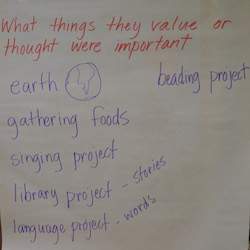 Read the first page from the information pages. On a piece of chart paper with the title "Description of the Shoshone People" already labeled, have the students tell you as many details as they can remember from what you read. Using the jigsaw method, divide students into five groups. Send them to the large papers or charts and markers placed around the room with the headings "Description of the land," "Description of their homes," "What they ate," "What their relationships were like," and "What things were valued in the culture." At each station have the specified reading page printed and available for students. Have each group read their section. (Make sure each group has a strong reader, or figure out a way to read it with them, possibly in small reading groups at a different time before this lesson.) After reading, each group should write as many details as they can about their reading.
Read the first page from the information pages. On a piece of chart paper with the title "Description of the Shoshone People" already labeled, have the students tell you as many details as they can remember from what you read. Using the jigsaw method, divide students into five groups. Send them to the large papers or charts and markers placed around the room with the headings "Description of the land," "Description of their homes," "What they ate," "What their relationships were like," and "What things were valued in the culture." At each station have the specified reading page printed and available for students. Have each group read their section. (Make sure each group has a strong reader, or figure out a way to read it with them, possibly in small reading groups at a different time before this lesson.) After reading, each group should write as many details as they can about their reading.
Come back together, and have the groups share what they learned from their section. Read the final section "Northwestern Shoshone People Today." Students should again share details from this section as well as details from their group's reading to add to the chart for this section. Discuss the information learned about the Northwestern Shoshone people.
Teacher: As we listen to the song again pay attention to the visual image in your mind.
Listen to the recording of "Pengwi Bai Anoga."
Teacher: Did your visual image change from the first time you listened? Did the mood of the song change based on the information you now know?
Again, have students use the strategy "Think, Pair, Share" to respond. Write their responses on the same chart and compare their initial responses with these second responses.
Teacher: We are going to learn to sing the Shoshone words, now that we know what the words mean and a little more about the people who sang and still sing this song.
Listen to the recording of Paula Watkins saying the words. Copy the way she says the words. Sing the words slowly using the phonetic guide as necessary to help with pronunciation. Sing along with the recording of her singing. When the class feels comfortable, sing the song without the recording. Sing the song several times.
Music extension: Compare and contrast the melody and words of "Pengwi Bai Anoga" with the melody and words of The Trout by Franz Schubert.
Session 2: Creating a story for the song
Teacher: Listen to the song again. As we listen you can choose whether you are going to show the melodic contour with body levels or trace the contour in the air with your finger.
Observe how well the students are able to show the melodic contour individually.
Teacher: Now we're going to sing the song with the Shoshone words.
You can either sing with the recording or a cappella (unaccompanied), depending on the students' ability and preference.
Teacher: Let's review what the words mean. What does "pengwi" mean? (fish) How about bai? (upon or above) Anoga? (waves) And the last word in the song is buhip. What does that mean? (green or grass) Last time we discovered that there were two main sections of the song. We called them Section A and Section B. How do the words relate to the two separate sections?
Listen to student responses.
Teacher: One reason for having two sections in the song might have been to show and compare two things the composer noticed/enjoyed while being in nature. Put yourself in the place of the Shoshone composer of the song. (The word "composer" is another way of saying someone who writes music.) Think about the information we learned about Northwestern Shoshone people as you consider possible answers to the following questions. Where were you? What were you doing? How did you create this song? Why did you create the song?
Using student responses, model how to write a story (in about five minutes) that describes a situation where a Shoshone person might have composed "Pengwi Bai Anoga." Review the charts students created yesterday from the informational text about Northwestern Shoshone people for facts that might help to create rich details.
You will use this story model as an example for the individual stories the students are going to be writing.
Teacher: Each of you is going to write your own story now. It's not going to be about the two things the composer noticed in nature, but about two things that you notice and value in nature.
If possible, arrange to take students outside to allow them to focus and observe nature around them with all of their senses. (If it is not possible to go outside, give students a few minutes to brainstorm a list of the things they would find in their favorite place in nature.)
Teacher: As you are outside, pay attention to how all of your senses perceive the things around you. Select two things to really focus on. How do those two things relate to one another? What details do you notice? Why do you think these two things are important to pay attention to? Do you see patterns in nature?
Teacher: You are now going to write your own story about things that you noticed in nature. In your story do your best to use descriptive details. Include the setting, who the characters are (this will be a description of you, and if you included anyone or anything else a description of them as well), and the sequence of events. These events should include noticing first one thing you thought was important to pay attention to in nature, and then the details of noticing a second thing in nature and its relationship to the first thing. Finish your story by finding a way to provide a sense of closure.
| Narrative Writing Success Criteria |
|---|
| Setting (with descriptive details) |
| Characters (with descriptive details) |
Sequence of events including:
|
| Provide a sense of closure to the narrative |
After 15 minutes, have students share their story with a partner, and turn in their writing to you.
Teacher: We are going to create musical compositions based on the stories you just wrote or possibly combinations of ideas from a few people's stories. We will first do this together, and then will break into small groups where you will create your own music. We will follow the pattern of the Northwestern Shoshone Fish Song, but will have freedom to arrange things according to our individual ideas too.
Teacher: Do you notice that "Pengwi Bai Anoga" only has three words in each phrase? Following that pattern, as we write lyrics, we will also select only a few words (between two to five words) to create a phrase that will represent the first thing that 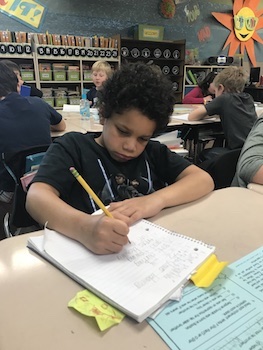
- Bird feathers rustling
- Tree leaves rustling
Teacher: Next, you will find a way to use repetition in your lyrics. The Northwestern Shoshone song repeated the entire three word phrase three times. You might decide to follow that same pattern, or only repeat part of the phrase, one word in the phrase, or only repeat a part of one of the words in the phrase. However, once you pick a way to use repetition, use the same type of repetition for the second phrase. You can also choose to include musical nonsense syllables in your phrase, but this is not a requirement as part of your lyrics. Here's what these types of repetition might sound like with the two phrases from the example I shared.
| Whole Phrase Repetition |
|
| Part Phrase Repetition |
|
| One Word Repetition |
|
| Part of the Word Repetition |
|
| Nonsense Syllables |
|
Teacher: As you think about repetition, you can decide on the pattern for your entire song as well. Do you remember the pattern, or form, of the entire song "Pengwi Bai Anoga"? Let's write it down together.
Listen and write down student responses.
Teacher: "Pengwi Bai Anoga" had a pattern where the first entire line (with all of the repeated words) was repeated two times before we heard the second line of the song, which was also repeated two times, but with small differences the second time the phrase repeated. The entire song was then repeated two more times. We would write the form as AABB1AABB1AABB1. You might decide to follow a similar pattern in your song, or do something completely different. You will need to work together as a group to decide on your overall form. Write it down along the top of your notation paper, so you can remember your decision.
Model doing this on the board.
Teacher: After figuring out the lyrics and form, you will next figure out a melody for your lyrics. Help me remember what specific notes were used in "Pengwi Bai Anoga."
Touch your head and if necessary help the students remember that the note there is "la." Touch your shoulders while the students sing "sol." Continue by touching your waist, knees, and toes while the students sing "me", "re", and "do" respectively.
Teacher: We are only going to use these five notes in our songs as well. You can put the notes in any order, so there are unlimited possibilities. The melody for your first phrase should be different from the melody for your second phrase, but the two melodic phrases should have something in common that makes them feel like they belong to the same song. For example, in "Pengwi Bai Anoga" both phrases end on eight do's (touching your toes). Listen to this melody that is a possibility for the lyrics created earlier using a combination of these five notes. Sing the music below or create your own melody as a model for students to hear. A recording is available to play for students if you don't feel comfortable singing it. (recording sample 1)


Teacher: Or how about this new possibility that also changes up the type of repetition and the melody?
Sing from the notation or play from available recording. (recording sample 2)
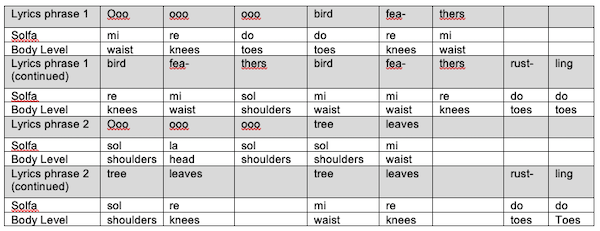
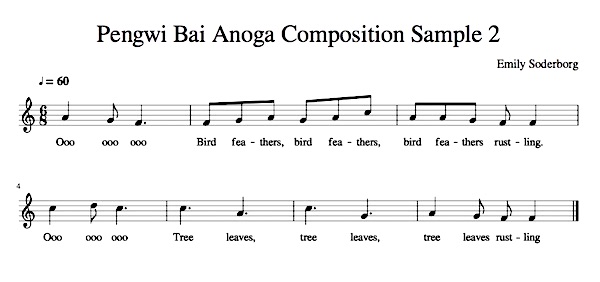
Teacher: Once you have figured out your melody, write it down in a way that makes sense to you. Maybe your group will decide to draw a contour map, or perhaps you will write down the levels of your body. You could write down the solfa names or if you know music notation, you are welcome to use that too. There is no wrong way to notate your melody. The thing that matters is that you can follow it and use it to help you remember how your song goes, and which notes match with which words in your song. Once you have practiced it and feel confident, we will create a recording of your group's composition.
As you prepare to record groups' compositions, select any recording software or app that you are comfortable with. Possibilities include voice recorder/voice memos on phones or chrome books or apps and websites like GarageBand, Audacity, or soundtrap.com.
Note: This composition project does not focus on having students figure out the rhythm for their songs. They are only notating the melodies. If students would benefit from a challenge, you can ask them to find a way to show the rhythm in their notation as well as the melody. Their notation does not need to be standard music notation, but can be anything that makes sense to the individual students in each group. You can also tell students that the goal of notation for a music composition is for someone else to be able to read and follow what they have written, thus creating something that sounds like what the composer has imagined.
Extension: Study other song lyrics or poetry that talks about nature.
Session 3: Creating Music Compositions
Note: Before this session begins, create small groups of three or four students to work together to create music compositions. These groups could be created after reading through students' individual stories and grouping according to common ideas, or they could be based on other grouping criteria.
Have students sit near their group members as this session starts. Go through the success criteria for the music composition. Make sure each group has paper and pencils to work with.
| Pengwi Bai Anoga Music Composition Success Criteria |
|---|
| 1st line of lyrics: Select a set of between 2-5 words that create a phrase representing something observed in nature |
| 2nd line of lyrics: Select another set of between 2-5 words representing another thing observed in nature. Find a way to connect the two phrases using deliberate word choice. |
Use repetition in the lyrics. Both lyric phrases should use the same type of repetition. You may choose between:
|
| (Optional) Include musical nonsense syllables within your phrases (such as la-la, mmm-hmmm, do-be-do, oooh, ahhhh, and so on) |
| Decide on the overall form of the piece. This means deciding how many times entire phrases are repeated. If the first line of lyrics is labeled A, and the second line of lyrics is labeled B your pattern might be ABABAB, AABBAABB, AABAAB, or something different. Write down your form on the top of your music notation paper. |
| Figure out a melody for both phrases using a combination of the five notes (lsmrd) we have been showing on our body levels. Even though the two phrases should be different from each other, they should also have something in common that makes them sound like they belong in the same song. |
| Write down your song in a way that makes sense to the members of your group. (possibilities might include a melodic contour map with lyrics added, writing out the solfa using only the alphabet letters, writing the order of body levels, or even a picture or something else that is meaningful to you. As you write your notation, make sure you can follow it and use the notation to help you remember how your song goes and which notes match with which words in your song. |
| Once you have practiced and feel confident, work with the teacher to create a recording of your composition. |
| Write an individual composer's statement sharing why this composition is an expression of your culture. |
Once most groups have at least gotten their melodies written, have the students pause working and leave their notation at their seats, and gather at the carpet to discuss the connections the music has with the culture of the people.
Teacher: I want you to think about your own culture. Culture can be defined as a pattern of behavior shared by a society, or group of people. Many different things make up a society's culture. These things include food, language, clothing, tools, music, arts, customs, beliefs, and religion. (Culture definition adapted from https://kids.britannica.com/kids/article/culture/399913)
Teacher: How do you think "Pengwi Bai Anoga" is an expression of Northwestern Shoshone culture?
As you help students come up with ideas, a possible answer might sound something like the following: "Pengwi Bai Anoga" shares musical traits of the Northwestern Shoshone music. It is sung in their language. Through the lyrics it shows that the people value nature and respect the environment around them.
Teacher: How can your music, in a similar way, represent the cultures of those in your group? As you continue working, write a composer's statement that explains why this composition is an expression of the people in your group's culture.
Compare cultural perspectives towards the natural environment (the individuals in the classroom and the Shoshone people, and possibly other groups the students know about) using a Venn Diagram.
Teacher: Let's see if there are similarities and differences between the perspective of those in this classroom and the perspective of the Northwestern Shoshone people in regards to the natural environment. What things does modern American culture think about the environment? Do you remember what we read about how the Shoshone people thought of the earth? (refer to the chart made during session 1 titled "What they thought about the earth." Fill out the Venn Diagram and discuss the similarities and differences found.
Fill out the Venn Diagram and discuss the similarities and differences found.
Teacher: We have been talking a lot about the Northwestern Shoshone people's past, but it is important to remember that there are still people alive today that are a part of this culture. From what we have learned, how would you describe how Shoshone people maintain cultural traditions today?
Teacher: Cultural traditions are maintained through what is shown as being valued (where time and focus is spent). We can see from the song "Pengwi Bai Anoga" that Northern Shoshone people value nature, and spending time there. We can also see from the song that singing the song in their language is also a way culture is maintained. Through the singing you are not only preserving the music aspect of culture but also language, values, customs, and beliefs. Many people who are trying to maintain their culture find that if they are able to keep their language alive they are also able to maintain an entire culture because language is a primary way to preserve culture. And sometimes singing the language is easier to remember than just the spoken words.
Teacher: Looking back to the specific text, we also found that the Northwestern Shoshone people are actively working to maintain their culture through several projects including the Singing Project, the Library Project, the Shoshone Language Revitalization and Maintenance Project, and the Beading Project. What specific aspects of culture does each of these projects help maintain?
(Possible answers the students might come up with might be something like the following)
Singing Project: depending on the songs being learned the Northwestern Shoshone language, tools (possibly music instruments used), music, arts (if dances are done with the songs, or specific clothing is worn to perform the song,) customs (who should sing the song and when), beliefs (what the songs are about), and religion (if the songs have religious aspects) might all be aspects of the music that are being taught and passed from one person to another.
The Library Project: The Northwestern Shoshone value education, so that is an overarching belief being promoted. The repository of cultural knowledge within the library includes information on many various aspects of the culture (including food, language, clothing, tools, music, arts, customs, beliefs, and religion.)
The Shoshone Language Revitalization and Maintenance Project: This project focuses mainly on the language aspect of culture. The language is considered endangered, because the younger generations are no longer acquiring the language, so this project is urgently needed before the last fluent speakers are no longer available to pass on their knowledge.
Beading Project: This project is focusing on preserving the aesthetic heritage (arts) of their tribe by teaching others how to make beautiful traditional adornments
Conclude the lesson by listening to and singing the Northern Shoshone words for "Pengwi Bai Anoga" again.
Allow students to work on their music compositions in available time over the next few days.
Extension: Tie in to science curriculum by categorizing the things in the students' stories and compositions as either living or non-living things.
Extension: Have students create illustrations for their stories or compositions.
Learning Objectives
- Develop a deeper understanding of the Northwestern Shoshone people
- Describe how music serves as an expression of culture, both Northwestern Shoshone and personal
- Show melodic contour of a song
- Create both melody and words for a new composition
- Write a narrative to describe a real experience
- Read informational text and summarize details
Utah State Board of Education Standards
This lesson can be used to meet standards in many grades and subject areas. We will highlight one grade’s standards to give an example of application.
Grade 3 Social Studies
Standard 3.2.2: Describe how geography (that is, physical features and natural resources) has shaped where and how their community developed, how it sustains itself, and how it will sustain itself in the future.
Standard 3.2.3: Define their own cultures or the cultures of their communities (for example, art, music, food, dance, system of writing, architecture, government to which they are regularly exposed or of which they are part).
- Standard 3.4.1: Choose a community outside of the United States. Locate that community on both print and digital maps of the Earth, their continent, country, and city or town, and contrast their sizes and the relationships in scale.
- Standard 3.4.3: Define the cultures of the community they chose in 3.4.1 (for example, art, music, food, dance, system of writing, architecture, government, religion).
Grade 3 Music
- Standard 3.M.CR.1: Improvise rhythmic and melodic patterns and musical ideas for a specific purpose using a specific tone set and simple meters.
- Standard 3.M.P.5: Respond to visual representations of melodic contour and simple melody patterns.
- Standard 3.M.R.4: Describe feelings or imagery conveyed by a music selection.
- Standard 3.M.CO.1 Describe how music relates to personal, social, emotional, and intellectual development; use life experience and additional content knowledge to inspire and respond to music and deepen understanding of another content area through music.
Grade 3 English Language Arts
- Standard 3.R.6: Read a variety of texts including those from diverse cultures, retell the text according to the text structure including the main idea and how key details support the main idea. (RL & RI)
- Standard 3.W.3: Write narrative pieces to develop real or imagined experiences or events using effective technique, descriptive details, event sequences, and provide a concluding statement.
Equipment and Materials Needed
- Sheet music for "Pengwi Bai Anoga" for teacher's personal information, but not used in lesson (see PDF)
- Recording of Paula Watkins singing "Pengwi Bai Anoga" (attached sound file)
- Recording of Paula Watkins speaking the translation (attached sound file)
- Phonetic guide of "Pengwi Bai Anoga" (see PDF)
- Melodic contour map (see PDF)
- Melodic contour map with solfa included (see PDF)
- Solfege handsigns chart (optional) https://www.classicsforkids.com/curwen-glover-hand-signs/
- At least 5 pieces of chart paper with markers
- Information paragraphs about the Northwestern Shoshone people (see PDF)
- Individual student writing materials (paper, pencils) for two separate activities
- Success Criteria Charts (see PDF)
- Writing Success Criteria Chart either displayed as students write or printed for each individual student to check off
- Musical Composition Success Criteria Chart either displayed as student groups work or printed for each group to check off
- Recording of composition sample 1 (optional) (attached sound file)
- Recording of composition sample 2 (optional) (attached sound file)
- Audio recording device (ipad, chromebook, laptop, phone, or another option in your classroom)
Additional Resources
This lesson was created thanks to a grant from the National Endowment for the Arts and the Utah Division of Arts & Museums.
- The Northwestern Band of the Shoshone Nation's website is a wonderful resource. https://www.nwbshoshone.com/
- A folktale illustrated by Northwestern Shoshone tribal children also includes reference information in the back of the book. Shoshone Nation, Northwest Band, "Coyote Steals Fire" (2005). All USU Press Publications. 81. https://digitalcommons.usu.edu/usupress_pubs/81
- Additional information about the Northwestern Band of the Shoshone Nation can be found in Newe Hupia: Shoshoni Poetry Songs, by Beverly Crum, Earl Crum, et. al. This incredible resource also includes sound files of many more Shoshone songs. https://digitalcommons.usu.edu/usupress_pubs/24/
- The following website includes information about song mapping. The map used in this lesson would be considered a lead map, but student initiated maps could be created as well. https://songworkseducatorsassociation.com/songworks/song-mapping.pdf
Image References
Image 1: James Huston
Image 2: The Northwestern Band of the Shoshone Nation
Image 3: James Huston
Images 4,5: Emily Soderborg
Images 6-9: Brenda Beyal
Images 10-12: Emily Soderborg
© Brigham Young University and the Northwestern Band of the Shoshone Nation

www.education.byu.edu/arts/lessons
 Download
Download